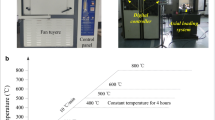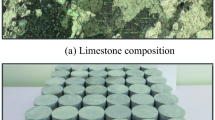Abstract
Engineering problems associated with high-temperature rock, such as the deep disposal of high-level radioactive nuclear waste, underground gasification and storage of coal, development of geothermal resources, restoration of important buildings after a fire, among others, have drawn the interest of many engineers and become a new and developing field of rock mechanics. In our study, we conducted the uniaxial compression test under conditions of high temperatures (T) that range from 20 °C to 800 °C and loading rates (lr) that vary from 0.001 to 0.1 mm/s, using the MTS 816 rock mechanics testing system, with the aim to investigate the evolution of deformation and intensity parameters of the limestone. The results show that the uniaxial compression process of limestone at different temperatures and loading rates comprises four stages: compaction, flexibility, yielding and post-peak failure. With increasing temperature, the ductility of limestone, the peak strain and the maximum strain after failure increase, and the post-peak softening characteristics of limestone gradually become obvious; however, the peak stress and elastic modulus of limestone decrease gradually. With increasing loading rate, the slope of the stress–strain curve in the elastic stage increases, and the deformation and intensity parameters of limestone increase accordingly. At T ≤ 500 °C and lr ≤ 0.01 mm/s, the rock specimens undergo failure or tension–shear mixed failure. At T > 500 °C and lr > 0.01 mm/s, Y-shaped shear failure occurs in the rock specimens. The failure degree of the limestone becomes more severe with increasing temperature and loading rate. The results of this study provide a scientific basis for high-temperature rock engineering studies on the design and construction of deep geological underground storage areas for high-level radioactive nuclear wastes, geothermal development, among others.







Similar content being viewed by others
References
Bieniawski ZT (1970) Time-dependent behaviour of fractured rock. Rock Mech 2(3):123–137
Blanton TL (1981) Effect of strain rates from 10−2 to 10 sec−1 in triaxial compression tests on three rocks. Int J Rock Mech Min Geomech Abstr 18(1):47–62
Cai M, Kaiser PK, Suorineni F, Su K (2007) A study on the dynamic behavior of the Meuse/Haute-Marne argillite. Phys Chem Earth 32(8):907–916
Cho SH, Ogata YJ, Kaneko K (2003) Strain-rate dependency of the dynamic tensile strength of rock. Int J Rock Mech Min 40(5):763–777
Chong KP, Borest AP (1990) Strain rate dependent mechanical properties of New Albany reference shale. Int J Rock Mech Min Sci Geomech Abstr 27(3):199–205
Chopra PN (1997) High-temperature transient creep in olivine rocks. Tectonophysics 279(1–4):93–111
David C, Menéndez B, Darot M (1999) Influence of stress-induced and thermal cracking on physical properties and microstructure of La Peyratte granite. Int J Rock Mech Min 36(4):433–448
Duclos R, Paquet J (1991) High-temperature behaviour of basalt-role of temperature and strain rate on compressive strength and K 1C toughness of partially glassy basalts at atmospheric pressure. Int J Rock Mech Min Sci Geomech Abstr 28(1):71–76
Ferrero AM, Marini P (2001) Experimental studies on the mechanical behaviour of two thermal cracked marbles. Rock Mech Rock Eng 34(1):57–66
Glover PWJ, Baud P, Darot M, Meredith PG, Boon SA, LeRevelec M, Zoussi S, Reuschlé T (1995) α/β phase transition in quartz monitored using acousticemissions. Geophys J Int 120(3):775–782
Hajpál M (2002) Changes in limestone of historical monuments exposed to fire or high temperature. Fire Technol 38(4):373–382
Heuze FE (1983) High-temperature mechanical, physical and thermal properties of granitic rocks—a review. Int J Rock Mech Min Sci Geomech Abstr 20(1):3–10
Kilic O (2006) The influence of high temperatures on limestone p-wave velocity and schmidt hammer strength. Int J Rock Mech Min Sci 43(6):980–986
Leiss B, Molli G (2003) High-temperature’ texture in naturally deformed Carrara marble from the Alpi Apuane, Italy. J Struct Geol 25(4):649–658
Liu RC, Jiang YJ, Li B, Wang XS (2015) A fractal model for characterizing fluid flow in fractured rock masses based on randomly distributed rock fracture networks. Comput Geotech 65:45–55
Luo JA, Wang LG (2011) High-temperature mechanical properties of mudstone in the process of underground coal gasification. Rock Mech Rock Eng 44(6):749–754
Mahmutoglu Y (2006) The effects of strain rate and saturation on a micro-cracked marble. Eng Geol 82(3):137–144
Mao RR, Mao XB, Zhang LY, Liu RX (2015) Effect of loading rates on thecharacteristics of thermal damage for mudstone under different temperatures. Int J Min Sci Technol 25(5):797–801
Meng QB, Zhang MW, Han LJ, Pu H, Li H (2016) Effects of size and strain rate on the mechanical behaviors of rock specimens under uniaxial compression. Arab J Geosci 9:527–541
Okubo S, Nishimatsu Y, He C (1990) Loading rate dependence of class II rock behaviour in uniaxial and triaxial compression tests-an application of a proposed new control method. Int J Rock Mech Min Sci Geomech Abstr 27(6):559–562
Olsson WA (1991) The compressive strength of tuff as a function of strain rate from 10−6 to 103 sec. Int J Rock Mech Min Sci Geomech Abstr 28(1):115–118
Peng SS (1973) Time-dependent aspects of rock behavior as measured by a servocontrolled hydraulic testing machine. Int J Rock Mech Min Sci Geomech Abstr 10(3):235–246
Peng SS, Podnieks ER (1972) Relaxation and the behavior of failed rock. Int J Rock Mech Min Sci Geomech Abstr 9(2):699–700
Qi CZ, Wang MY, Qian QH (2009) Strain rate effects on the strength and fragmentation size of rocks. Int J Impact Eng 36(12):1355–1364
Ranjith PG, Viete DR, Chen BJ, Perera MSA (2012) Transformation plasticityand the effect of temperature on the mechanical behavior of Hawkesbury sandstone at atmospheric pressure. Eng Geol 151:120–127
Rocchi V, Sammonds PR, Kilburn CRJ (2004) Fracturing of etnean and vesuvian rocks at high temperatures and low pressures. J Volcanol Geotherm Res 132(2–3):137–157
Su HJ, Jing HW, Mao XB, Zhao HH, Yin Q, Wang C (2015) Size effect of sandstone after high temperature under uniaxial compression. J Cent South Univ 22(5):1901–1908
Sun Q, Zhang WQ, Xue L, Zhang Z, Su T (2015) Thermal damage pattern and thresholds of granite. Environ Earth Sci 74(3):2341–2349
Sun Q, Zhang WQ, Su T (2016) Variation of wave velocity and porosity of sandstone after high temperature heating. Acta Geophys 64(3):633–648
Tarasov BG (1990) Simplified method for determining the extent to which strain rate affects the strength and energy capacity of rock fracture. J Min Sci 26(4):315–320
Tullis J, Yund RA (2012) Experimental deformation of dry westerly granite. J Geophys Res 82(36):5705–5718
Xu XL, Zhang ZZ (2016) Fractal characteristics of rock fracture surface under triaxial compression after high temperature. Adv Mater Sci Eng 9:1–10
Xu XL, Gao F, Shen XM, Xie HP (2008) Mechanical characteristics and microcosmic mechanisms of granite under temperature loads. J China U Min Techno 18(3):413–417
Yang SQ, Jing HW, Huang YH, Ranjith PG, Jiao YY (2014) Fracture mechanical behavior of red sandstone containing a single fissure and two parallel fissures after exposure to different high temperature treatments. J Struct Geol 69(Part A):245–264
Yang SQ, Ranjith PG, Jing HW, Tian WL, Ju Y (2017) An experimental investigation on thermal damage and failure mechanical behavior of granite after exposure to different high temperature treatments. Geothermics 65:180–197
Zhang QB, Zhao J (2014) A review of dynamic experimental techniques and mechanical behaviour of rock materials. Rock Mech Rock Eng 47(4):1411–1478
Zhang ZX, Yu J, Kou SQ, Lindqvist PA (2001) Effects of high temperature on dynamic rock fracture. Int J Rock Mech Min Sci 38(2):211–225
Zhang LY, Mao XB, Lu AH (2009) Experimental study on the mechanical properties of rocks at high temperature. Sci China Technol Sc 52(3):641–646
Zhao YS, Wan ZJ, Feng ZJ, Yang D, Zhang Y, Qu F (2012) Triaxial compression system for rock testing under high temperature and high pressure. Int J Rock Mech Min 52:132–138
Acknowledgements
The financial and general support for this research as provided by the National Key R&D Program of China (No. 2016YFC0600900), National Natural Science Foundation of China (Nos. 51504237, 51704280, 51734009) and China Postdoctoral Science Foundation (No. 2017 T100420) is gratefully acknowledged.
Author information
Authors and Affiliations
Corresponding author
Rights and permissions
About this article
Cite this article
Meng, Q., Zhang, M., Han, L. et al. Experimental research on the influence of loading rate on the mechanical properties of limestone in a high-temperature state. Bull Eng Geol Environ 78, 3479–3492 (2019). https://doi.org/10.1007/s10064-018-1332-4
Received:
Accepted:
Published:
Issue Date:
DOI: https://doi.org/10.1007/s10064-018-1332-4




